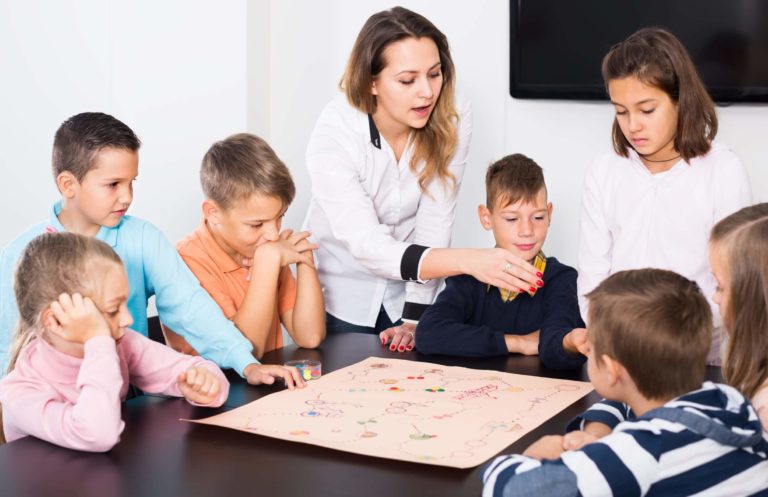Adapting teaching methods to meet the needs of all students has become increasingly important for educators, especially post-COVID. Differentiated instruction is a teaching strategy used to accommodate students’ diverse learning needs.
In this post-COVID era, where students have experienced varied levels of engagement and comprehension, differentiated instruction has become a powerful and popular tool to ensure students will thrive academically. As educators continue to cater to diverse learning styles, many are using classroom games as a fun and effective way to differentiate instruction in their classrooms.
What is Differentiated Instruction?
Differentiated instruction is a technique that accommodates the learning style, readiness, and interests of every student. It typically involves using various instructional methods to convey identical information to students depending on their learning style. The primary objective of differentiated instruction is to ensure that all students are engaged in the learning process by providing tasks that align with each student’s specific needs.
In the aftermath of the COVID-19 pandemic, a more personalized approach to learning has gained popularity more so than the traditional one-size-fits-all approach that is typically been used in classrooms. This may be due to the extended period using remote or hybrid learning, which showed educators needed to be more flexible and adaptable to the needs of students.
Why Games are an Effective Way to Differentiate Instruction
There are several ways teachers can differentiate instruction, including flexible grouping, learning centers, tiered assignments, or providing students with a selection of activities to choose from. Although these methods can be engaging for students, integrating classroom games can be a more dynamic and interactive way to engage students using differentiated learning. Here are a few reasons why using classroom games can be an effective approach.
Collaborative Learning Opportunity
Games often encourage students to work together, fostering teamwork and building classroom community. This cooperative learning opportunity allows students with different strengths to contribute their unique strengths and skills based on their abilities.
Caters to Different Learning Styles
Games are inclusive and can cater to different learning styles. Whether a student prefers verbal interaction or a hands-on activity, games can accommodate different learning styles and modalities.
Reinforces Skills
Games offer students an opportunity to practice and reinforce specific skills. By playing games, students strengthen these skills, ensuring that they grasp the information through repetition. This is especially beneficial for any student who needs additional practice, a deeper understanding of a subject, or those who need to be challenged because they grasp concepts very quickly.
Varied Levels of Complexity
Many games offer diverse difficulty levels, making it easy for students to select levels based on their current skill set. This can empower students to tailor their learning experience as well as foster a personalized learning experience.
Intrinsic Motivator
Games tap into the internal motivation of students, where their natural curiosity and competitiveness to achieve and win lies. The element of competition or the desire to outperform their classmates can create an engaging and motivating learning experience for students.
How to Differentiate Instruction Using Classroom Games
Using classroom games can be an effective way to meet the diverse learning needs of your students. Here are a few tips to help differentiate instruction using classroom games.
Modify Rules
Adapt the rules of the game to meet the needs of all students. You can do this by creating varied levels of difficulty. For example, if playing a math game, you can adjust the complexity of the problems to suit the varying skill levels of each student. If playing a science game on biology, you can customize the questions to cover different branches of biology allowing students to choose which branch they want to focus on. You can do the same thing for a geography quiz or historical events.
Allow Game Choice
Offering a selection of games or allowing students full autonomy not only will align them with the games that pique their interest but will also help to foster a sense of ownership over students’ learning. In addition, it can help them stay motivated and engaged in the learning process. For example, let’s say students were learning about the solar system. One game option can be a trivia challenge for more advanced learners, another can be a board game about planet facts, and another can be a hands-on game that reinforces concepts.
Rotate Game Stations
Rotating stations is an effective strategy to differentiate instruction using classroom games. This approach allows you to address diverse learning styles and cater to individual preferences. For example, different stations can focus on specific skills or concepts allowing students to move from station to station based on their needs. This will also ensure you’re appealing to all learning preferences.
Try Flexible Grouping
Flexible grouping allows you to tailor learning experiences based on the abilities of individual students. When you form groups based on varying levels of ability, style, and interest, you can cater to specific groups. This approach ensures that each student receives targeted instruction that maximizes their learning experience as well as challenges them. Additionally, peer collaboration is an added benefit where students can play off one another’s strengths.
Incorporate Reflection and Feedback
Embedding reflection during gameplay can be an effective strategy. Pre-game reflection can be a good starting point and help to set the stage for students’ current standing of information while post-game reflection can help students gain a deeper understanding of the game and what they’ve learned. Peer feedback can also be an effective way to enhance learning because it helps to create a supportive learning environment where students learn from one another and can share different strategies.
By incorporating differentiated instruction through classroom games, you are meeting all students’ diverse needs and creating an inclusive and engaging learning environment. Facilitating interactive games can also help to instill a love for learning that goes far beyond the classroom.




